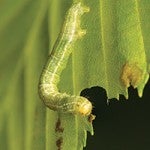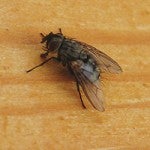Battle of the Bugs
 An invasion is taking our trees, and one URI scientist might have the solution.
An invasion is taking our trees, and one URI scientist might have the solution.
European Winter Moth caterpillars arrived in Canada around 1950 and made their way to Rhode Island 10 years ago. With no known predators, they’ve taken up residence in numbers large enough to defoliate trees and pose a threat to apple and blueberry growers.
Heather Faubert ’81, coordinator of the University’s Plant Protection Clinic, is working with colleagues to rear and release a parasitic fly, Cyzenis Albicans, which reduced the winter moth population in Nova Scotia in the 1950s. The flies lay eggs on tree leaves, the caterpillars eat the eggs, and fly larvae grow inside their hosts, killing them.
Her effort faces a conundrum. “You need large populations of the moths for the flies to do their job,” Faubert explains, “but it takes several years for the fly population to establish itself.” So she’s spent the last several years scouting for moth infestations.
 Faubert released 1,600 parasitic flies at Goddard Park in East Greenwich in 2011, followed by releases in Bristol and Jamestown in 2013, and this spring in South Kingstown, Cumberland and Jamestown again. She’ll target more sites in coming years. “Hopefully within about five years, the flies will take care of the problem,” she says.
Faubert released 1,600 parasitic flies at Goddard Park in East Greenwich in 2011, followed by releases in Bristol and Jamestown in 2013, and this spring in South Kingstown, Cumberland and Jamestown again. She’ll target more sites in coming years. “Hopefully within about five years, the flies will take care of the problem,” she says.
Meanwhile, as moths become more prolific, Rhode Island homeowners are taking notice, flooding the phone lines at state agencies and the URI Master Gardener Hotline. Until the flies take hold, there’s little to be done. For prized landscape trees that aren’t near forest edges, Faubert advises using spinosad insecticides. For apple and blueberry growers, who are hard hit because the moth eggs begin hatching in the middle of April, when there is little food other than flower buds, she suggests spraying insecticides early in the season.
 Home
Home Browse
Browse Close
Close Events
Events Maps
Maps Email
Email Brightspace
Brightspace eCampus
eCampus




